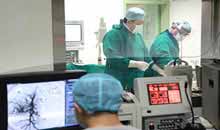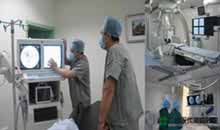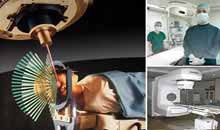- Basic
- Symptoms
- Diagnosis
- Treatments
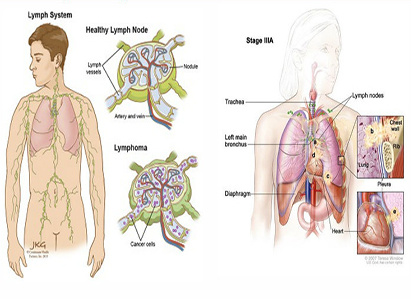
What is Lymphoma?
Lymphoma is a kind of malignant tumor originating from lymph node or other lymph organizations; currently there are nearly 70 pathological types, and it is mainly divided into the two categories: Hodgkin lymphoma and non-Hodgkin lymphoma.
Causes of Lymphoma
1. Physical causes: the onset of lymphoma is related to irradiation absorption, large dose of irradiation urge the occurrence of human’s lymphoma;
2. Chemical causes: chemical carcinogen, like pesticide, hair dye and so on;
3. Immunity factor: immunity hypofunction, like AIDS, organ transplantation, rheumatoid arthritis and so on;
4. Hereditary factor: the occurrence of malignant tumors has obvious trend of family gathering, for example, brothers or sisters can successively or simultaneously suffer from malignant lymphoma;
5. Virus causes: viral infection, like HTLV, HIV, EB, etc.
Besides, long term acid body constitution is the well known cause for lymph canceration.
High Risky Group of Lymphoma
According to concerned statistics, there is one new lymphoma case emerge every 9 minutes, in which the proportion of young adults between 20-40 years old is increasing. This is because lymph tissue of young adults are in active stage, the high sensitive of lymph tissue makes them easily become high risky group of lymphoma.
Nursing of Lymphoma
1. Encourage patients to actively cooperate with and receive treatments to enhance the confidence of fighting disease;
2. Enhance nutrition supply, eat more easily digested food rich in high protein, vitamins and improve immunity;
3. Suitably do some exercise and improve the physical constitution; when fever or other obvious symptoms caused by tumor invading other organ emerge, get some rest to prevent body consumption and protect the organism;
4. Keep skin clean and swab the body with warm water, especially protect the skin of radiotherapy exposed area to prevent the stimulus of sun solarization, antiseptics, soap imposed to the skin.

Lymphoma is a malignancy of immune system can develop in any part of body. It usually appears as a solid tumor in the organs rich in lymphatic tissues and tends to encroach on lymph nodes, tonsil, spleen and bone marrow. It is easily ignored because of insidious symptoms. But the survival rate can highly improved if its symptoms are noted in early stage and take treatments in time. Therefore, it is necessary for us to know some symptoms of lymphoma.
1. The most typical symptoms of lymphoma are painless superficial lymph nodes, which grow gradually with smooth surface and in the hardness like nasal tip. Swelling lymph nodes are most commonly occurring in neck and supraclavicular regions, after that are in armpits and inguens. Some cases would mainly present the symptom of swelling lymph nodes deep in body, for example, swelling lymph nodes in mediastinum, abdominal cavity and pelvis. Those cases come with an insidious onset that when the patients are diagnosed lymphoma, the swelling lymph nodes deep in body normally are every obvious to note.
2. Progressive swelling lymph nodes may affect or press on tissues or organs around and cause correspondent symptoms. For example, when superior vena cava is pressed by the swelling lymph nodes in mediastinum would block blood backflow to cause swollen face and neck, chest distress, chest pain or difficult breath and so on. If the swelling lymph nodes of pelvis and abdominal cavity press on gastrointestinal tract, ureter or bile ducts etc. would lead to intestinal obstruction, hydronephrosis, jaundice, which may also come with abdominal pain and distention.
3. Expect lymphatic system, lymphoma can also encroach on other organs and present correspondent symptoms. For instance, gastrointestinal lymphoma would show the symptoms like abdominal pain, gastrointestinal ulcer, bleeding and oppression etc., which are same as stomach diseases and intestinal cancer do. Lymphocytoma cutis is normally mistaken as psoriasis, eczema and dermatitis. If the tumor develops in brain, headache, blurring vision, disturbance of speech, unconsciousness, and change in disposition, dyskinesia of limbs or whole body, and even paralysis in severe cases. When tumor invades bones can lead to pain or fracture of bones, and if in nasopharynx may develop symptoms like nose obstruction, running nose, nasal bleeding, which are similar to the ones of nasopharyngeal cancer.
4. Lymphoma is a general disease, except the above symptoms, fever, night sweat, acratia, emaciation, loss of appetite, rash, itching, anemia and other systematic symptoms may develop in more than 50% patients. From this, superficial lymphoma comes with obvious symptoms that are easy to find early. But for the lymphoma develops deep in body, it is difficult to note because concerning symptoms would occur when the tumor is large enough.
Specialist from Modern Cancer Hospital Guangzhou reminded that, some diseases may also present the symptoms mentioned above, a patient may not suffer from lymphoma once these symptoms occur and should go to hospital for examinations in time. Then if a patient is diagnosed lymphoma, timely treatments can perform to improve therapeutic effect and living quality.

The diagnosis of lymphoma can not be worked out blindly, since clinical symptoms vary when lesion location and range change, and blind diagnosis will increase the misdiagnosis rate. And below are the examinations may help a patient diagnose lymphoma.
1. Imaging examination
1)X-ray is to observe the lymph nodes of lung hilum, midiastinum, carina tracheae and endosperm, while it can observe if any infiltration in lung hilum occurs. The obvious swelling lymph nodes in anterosuperior mediastinum and lung hilum may indicate the sign of malignancy, but before that the swelling lymph nodes arising from extrapulmonary tuberculosis, fungous infection or other cancers should be excluded. If a patient is suspected suffering from swelling lymph nodes in pelvis, retroperitoneum and paraaortic regions may have lower extremity lymphography for diagnosis.
2) Computerized tomography(CT). It can detect the lymph tissues which can not find through lower abdominal lymphadenography. Chest CT scan can help to diagnose mediastinal lesions and the lymph nodes closed to trachea, lung hilum and aortic clear space.
3)Magnetic resonance imaging (MRI) can reveal the structure of blood vessels and can have multidirectional and multi-plane scans inside body.
4) Radioisotopic scanning. Bone scans can find lesion early than X-ray. Bone scan can indicate the rising intake of nuclide in lesions. In addition, diffuse histocytic lymphoma normally would come with bone infiltration.
5)Ultrasound examination can detect the lymph nodes over 2cm dia., however, it cannot identify if the increased lymph node is causing from cancer infiltration or reactive hyperplasia or chronic inflammation. Besides, through it can find the splenohepatomegalia and the obvious nodules in liver or spleen.
Doctor would get some tissues from the tumor found in a lymphoma patient through imaging examinations for biopsy to confirm if the tumor is benign or malignant.
2. Biopsy
1) Biopsy of lymph nodes. Malignant lymphoma should be diagnosed through biopsy and pathological samples should mainly be lymph nodes.
2) Biopsy of bone marrow. The incidence for lymphoma encroaches on bone marrow can highly reach 40%~90%. Bone marrow biopsy can confirm if malignant lymphoma encroaches on bone marrow and it normally has to be performed through puncture.
3)Biopsy of liver. In Non-Hodgkin lymphoma cases, small lymph cells and small cleaved cells are more tending to encroach on liver.
4) Blood picture. The white blood cells of Hodgkin’s disease in most cases are within normal range while little patients appear mild or obvious increase of white blood cells. Besides that, a non-Hodgkin lymphoma patient would present abnormal increase of white blood cells and is accompanied by opposite or absolute increase of lymph cells.
Modern Cancer Hospital Guangzhou reminds that when swelling and other abnormality occur in body, the patient should go to hospital timely for examination and treatments, by which can effectively control the disease.
After being diagnosed with lymphoma, patients are rush to take related treatments. However, only when patients find the suitable treatments according to individualized condition, will they get a best therapeutic effect.
Experts from Modern Cancer Hospital Guangzhou introduce the traditional lymphoma treatments and advanced lymphoma treatments for patients so that they could make a wise treatment option with smaller trauma, fewer side effects and better efficacy.
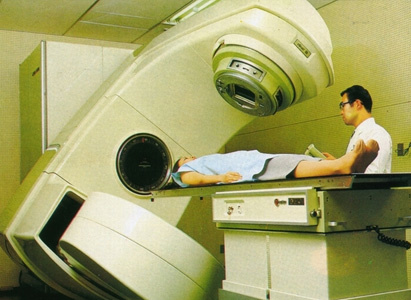
Traditional Lymphoma Treatments:
1. Surgery
Surgery may not bring a good effect to lymphoma treatment because lymphoma is usually a systemic disease and it is hard to thoroughly remove all the cancer cells during the surgery. The residual cancer cells possibly cause cancer recurrence.
2. Chemotherapy
Chemotherapy is capable of alleviating the symptoms of lymphoma, relieving the pain of lymphoma patients, reducing the number of lymphoma cells and controlling the development lymphoma within a certain period. However, chemotherapy usually also brings toxic side effects to patients which make patients suffer from hair loss, bad appetite, dried skin, vomiting, etc.
3. Radiotherapy
(1) Hodgkin lymphoma: cloak 'or inverted Y' type radiation are most commonly seen, while sufficient protection shall also be given to vital organs.
(2) Non-Hodgkin lymphoma: this kind of lymphoma is sensitive to radiotherapy and easily re-occurs. For the non-Hodgkin lymphoma whose primary foci locate in tonsil, pharynx nasalis or tissue cells of bone, local radiotherapy may achieve the effect of relatively pleasing durable remission.

Advanced Lymphoma Treatments in Modern Cancer Hospital Guangzhou:
1. Interventional Therapy
Interventional therapy for lymphoma is one of the high-tech minimally invasive therapies under the guidance of medical imaging equipment. It targets the tumor directly in high drug concentration with 2mm small trauma, which is beneficial to lymphoma treatment.
2. 125I Seed Implantation
125I seed implantation is a short-range radiotherapy to implant 125I seed into the lymph lode or lymphatic system. After being transplanted into patients’ body, the seeds will constantly give off the short-range ray, which is capable of killing the cancer cells effectively.
3. Biological Immunotherapy
Immunotherapy applies the interactive function between immune system and tumor cells, enhances the resistance of immune system to tumor cells, inhibits and eliminates tumor growth in lymphatic system.
If you are a lymphoma patient and want to know which is the best suitable treatment according the individualized condition, please click online consultation.
If you have any questions, please contact us via online consultation, email or phone call. If you find our website useful, please follow our FaceBook and YouTube, health information will be updated regularly.









